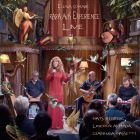A homage to American collectors.
Watch out folks here comes another THEME show, a very good one at that even if its exhibited in dead-black halls like funeral parlours. Who are the decorators who always insist on lugubrious windowless interiors and cruel spotlights in Palazzo Ruspoli, which make paintings look like reproductions?
The double theme, about Picassos influence and the classical modern paintings given to American museums, is actually about the latter. Picasso himself is represented by only four oils and four works on paper, among 36 other donations. The rest is a homage to the wonderful acuteness of rich and knowledgeable American collectors and their gifts influenced by Picasso or not to a host of American museums.
In contrast to the European tradition, where the big collections and museums were first put together by the Church and merchant princes, and then eventually taken over by the state, American museums are based on private donations and are run by private sponsors. Most cities, even very small ones, take pride in their independent museums of contemporary art, carefully selected and handsomely installed as tokens of American freedom and prosperity. We owe much to Albert Gallatin (Philadelphia, Pennsylvania) with his early Museum of Living Art, once a rival of the Modern, to Louise and Walter Arensberg (Baltimore, Maryland), Joseph Hirschhorn (Washington, DC) and Ferdinand Howald (Columbus, Ohio), and of course to Gertrude Stein and the Cohn sisters (Baltimore, Maryland), who helped shape our understanding of 20th-century art. So this group of works from museums far flung all over the United States, not easy to reach, which we may rarely be able to study again, is a glad occasion.
Of course that ogre and other-peoples-pictures-eater Picasso, who absorbed and dissected giants throughout art history, overshadowed the production of art from the 1920s to the 1940s not only in Paris but also in New York. Practically inventing Cubism after Czanne and Futurism he went further than most in the breaking up of objects, seeing them from different angles in split-up space. Always a leader in new exploration, he also furthered a sort of curvi-linear abstraction, which derived from Surrealism. The show is articulated into arbitrary categories, which could be debated. But besides the cubist and post-surrealist modes coming from the master, there was also American regional art the Ashcan school and the Mexican muralists Rivera, Orozco, Siqueiros influenced by the renaissance painter Masaccio. If we look closely, we can find these threads here too.
The show begins with an early Picasso landscape, which is Cubist but doesnt know it. (Paesaggio di Horta del Ebro, 1909). Unknown in Europe are the American Cubists Morgan Russel and Macdonald-Wright. The latters Californian landscape in sunny segments could just as well be depicting the south of France. Alice Trumbull Masons Brown shapes White plays with amorphous shapes and singing sharp line. Stewart Davis happily and shamelessly takes lessons from the brightness and punchy simplicity of advertising; and it is good to see the sturdy little-known Max Weber. Again, of the Europeans, Alexeij Jawlenski shines, and of course there are examples of Albert Leon Gleize, Georges Braque, Fernand Lger, Joan Mir and Roger de la Fresnaye, Auguste Herbin and others.
Only towards the end of our itinerary do we come upon the great surprises: the canvases encrusted with glittering snail trails of paint by Jackson Pollock and an early Willem de Kooning of 1942 with odd huge body shapes (but called The Waves), strangely hesitant, and despite its lan, from a time when he still had trouble finishing his pictures.
A 1944 Arshile Gorky (from the Seattle museum of art) looks so today it takes your breath away. With wild and glorious meanders of thin rainbow paint, it is wonderfully structured underneath. It is probably the most rebellious and wilful canvas here. It is even called: How My Mothers Embroidered Apron Unfolds In My Life.
Although Gorky, de Kooning and Pollock paid attention early on to Picasso, they burst through to a completely new and authentic American way of painting the school of New York. This, Abstract Expressionism, magnificently reveals and never fudges the raw labour of picture making; indeed it celebrates it.
There is a sadness here, not only due to the lugubrious installation. These bright things were born in rough studios reeking of smoke, drink and turpentine, in the thin air of danger and bliss, in moments of heightened consciousness and intuition. Like the work in the just newly-opened, scandalously overpriced, Modern in New York, they have become Classic Modernism. Pinned up like butterflies, enshrined in pretty frames in user-unfriendly darkness, they seem washed and flat. It takes a great effort of imagination to recapture their bewitching erstwhile freshness. It is worth it.
In the time of Picasso.
Donations from American Museums. Until 8 Jan 2005.
Fondazione Memmo. Palazzo Ruspoli.
Via del Corso 418. Tel. 066874704.


















